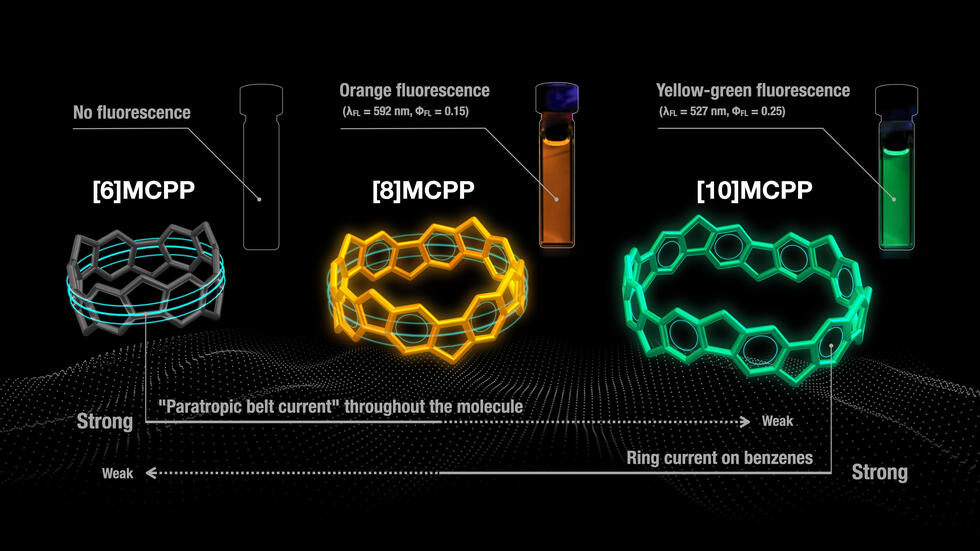
Chemistry
April 21, 2023
Fluorescent Aromatic Nanobelts with Unique Size-dependent Properties
A new type of aromatic nanobelt, methylene-bridged [n]cycloparaphenylene ([n]MCPP), has been synthesized and its properties elucidated by researchers at the Institute of Transformative Bio-molecules (WPI-ITbM) at Nagoya University in Japan, in collaboration with researchers at the Università degli Studi di Salerno in Italy and the University of Nevada in the USA.
The production of cyclic molecular nanocarbons such as carbon nanorings (CNRs) and carbon nanobelts (CNBs) is an emerging topic in chemistry. [n]Cycloparaphenylene ([n]CPP) was the first CNR and has dominated the chemistry of cyclic molecular nanocarbons in the last decade. CPPs exhibit unique size-dependent properties in their strain energies, dihedral angles between adjacent phenylene units, highest occupied molecular orbital - lowest unoccupied molecular orbital (HOMO-LUMO) gap, maximum fluorescence wavelength, fluorescence quantum efficiency, and guest-encapsulating properties. Compared to CNRs, CNBs with fused benzene rings have more rigid cyclic structures with significantly higher strain energy.
Now, a team led by Professor Kenichiro Itami (he/him) and Designated Associate Professor Akiko Yagi (she/her) of ITbM, Nagoya University, has synthesized methylene-bridged [n]cycloparapenylenes ([n]MCPPs, n = 6, 8, 10); nanobelts containing five-membered benzene rings bridged by methylene units. The key to successful synthesis is the use of pillar[n]arenes, which are commercially available cyclic aromatic molecules, as precursors to construct the nanobelt structure through an intramolecular coupling reaction.
Investigation revealed that MCPPs exhibit different properties depending on their ring size. As ring size increases, visible UV light is absorbed at longer wavelengths. This is in contrast to CPPs, whose spectra are independent of ring size. [6]MCPP shows almost no fluorescence, [8]MCPP fluoresces orange and [10]MCPP fluoresces yellow-green. The fluorescence values are very high for carbon nanobelts, suggesting that large ringed MCPPs could be used as fluorescent nanobelts, something that has never been seen before.
Previous theoretical studies have predicted that [6]MCPP exhibits a strong "paratropic belt current" throughout the molecule. In collaboration with research groups in Italy and the USA, the ITbM research group clarified that the paratropic belt current throughout the MCPP decreases as the ring size increases using both computational and experimental studies. This property was first elucidated by the synthesis of [8]MCPP and [10]MCPP, and this discovery has significant implications for the study of the magnetic properties of aromatic nanobelts. The team plans to continue the synthesis of other sizes of MCPPs to open up a new field of nanobelt science.
Original Article:
Hideya Kono, et al. Methylene-Bridged [6]-, [8]-, and [10]Cycloparaphenylenes: Size-Dependent Properties and Paratropic Belt Currents
J. Am. Chem. Soc. April 12, 2023.
Funding:
This work was funded by the Japan Science and Technology Agency (JST; JPMJER19R1); the Japan Society for the Promotion of Science (JSPS; JP19H05463).
Institute of Transformative Bio-Molecules (ITbM) website: